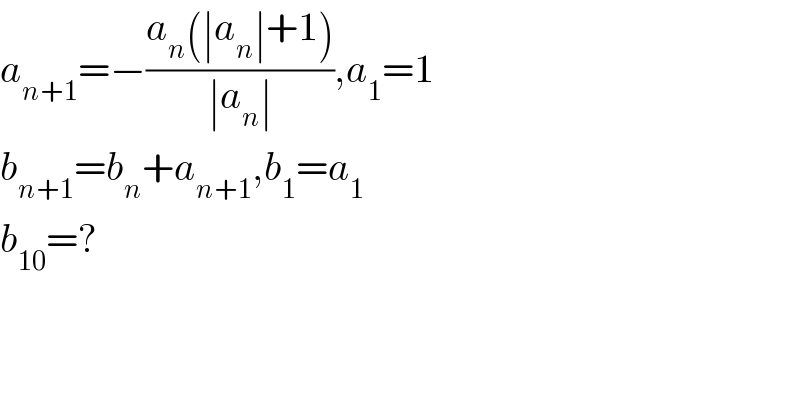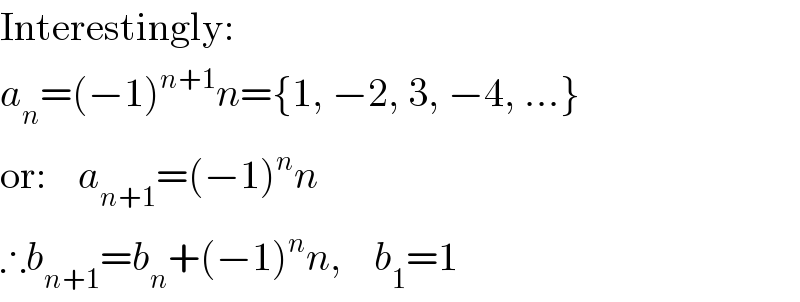
Question Number 2358 by 123456 last updated on 18/Nov/15

$${a}_{{n}+\mathrm{1}} =−\frac{{a}_{{n}} \left(\mid{a}_{{n}} \mid+\mathrm{1}\right)}{\mid{a}_{{n}} \mid},{a}_{\mathrm{1}} =\mathrm{1} \\ $$$${b}_{{n}+\mathrm{1}} ={b}_{{n}} +{a}_{{n}+\mathrm{1}} ,{b}_{\mathrm{1}} ={a}_{\mathrm{1}} \\ $$$${b}_{\mathrm{10}} =? \\ $$
Answered by Filup last updated on 18/Nov/15

$${continued}\:\left(\mathrm{without}\:\mathrm{working}\right) \\ $$$$\left(\mathrm{working}\:\mathrm{is}\:\mathrm{simple}\right) \\ $$$${a}_{\mathrm{1}} =\mathrm{1}\:\:\:\:\:\:\:\:\:\:\:\:{b}_{\mathrm{1}} =\mathrm{1} \\ $$$${a}_{\mathrm{2}} =−\mathrm{2}\:\:\:\:\:\:\:\:{b}_{\mathrm{2}} =−\mathrm{1} \\ $$$${a}_{\mathrm{3}} =\mathrm{3}\:\:\:\:\:\:\:\:\:\:\:\:{b}_{\mathrm{3}} =\mathrm{2} \\ $$$${a}_{\mathrm{4}} =−\mathrm{4}\:\:\:\:\:\:\:\:{b}_{\mathrm{4}} =−\mathrm{2} \\ $$$${a}_{\mathrm{5}} =\mathrm{5}\:\:\:\:\:\:\:\:\:\:\:\:{b}_{\mathrm{5}} =\mathrm{3} \\ $$$${a}_{\mathrm{6}} =−\mathrm{6}\:\:\:\:\:\:\:\:{b}_{\mathrm{6}} =−\mathrm{3} \\ $$$${a}_{\mathrm{7}} =\mathrm{7}\:\:\:\:\:\:\:\:\:\:\:\:{b}_{\mathrm{7}} =\mathrm{4} \\ $$$${a}_{\mathrm{8}} =−\mathrm{8}\:\:\:\:\:\:\:\:{b}_{\mathrm{8}} =−\mathrm{4} \\ $$$${a}_{\mathrm{9}} =\mathrm{9}\:\:\:\:\:\:\:\:\:\:\:\:{b}_{\mathrm{9}} =\mathrm{5} \\ $$$${a}_{\mathrm{10}} =−\mathrm{10}\:\:\:\:{b}_{\mathrm{10}} =−\mathrm{5} \\ $$$$ \\ $$$$\therefore{b}_{\mathrm{10}} =−\mathrm{5} \\ $$
Commented by Filup last updated on 18/Nov/15

$$\mathrm{Interestingly}: \\ $$$${a}_{{n}} =\left(−\mathrm{1}\right)^{{n}+\mathrm{1}} {n}=\left\{\mathrm{1},\:−\mathrm{2},\:\mathrm{3},\:−\mathrm{4},\:...\right\} \\ $$$$\mathrm{or}:\:\:\:\:{a}_{{n}+\mathrm{1}} =\left(−\mathrm{1}\right)^{{n}} {n} \\ $$$$\therefore{b}_{{n}+\mathrm{1}} ={b}_{{n}} +\left(−\mathrm{1}\right)^{{n}} {n},\:\:\:\:{b}_{\mathrm{1}} =\mathrm{1} \\ $$
Commented by Filup last updated on 18/Nov/15

$${a}_{{n}+\mathrm{1}} =−\frac{{a}_{{n}} \left({a}_{{n}} +\mathrm{1}\right)}{\mid{a}_{{n}} \mid},\:\:\:\left({a}_{\mathrm{1}} =\mathrm{1}\right) \\ $$$${a}_{{n}+\mathrm{1}} =−\mathrm{sgn}\left({a}_{{n}} \right)\left({a}_{{n}} +\mathrm{1}\right) \\ $$$${a}_{{n}+\mathrm{1}} =\mathrm{sgn}\left(−{a}_{{n}} \right)\left({a}_{{n}} +\mathrm{1}\right) \\ $$$$\:\:\:\:\:\:\:\therefore\:\mathrm{if}\:{a}_{{k}} =+\mathrm{ve},\:\:\:\:\:\:{a}_{{k}+\mathrm{1}} =−\mathrm{ve} \\ $$$$\mathrm{Now},\:\mathrm{knowing}\:\mathrm{the}\:\mathrm{sequence}\:\mathrm{gives}: \\ $$$$\mathrm{1},\:−\mathrm{2},\:\mathrm{3},\:−\mathrm{4},\:... \\ $$$$\mathrm{We}\:\mathrm{can}\:\mathrm{evaluate}\:\mathrm{that}: \\ $$$${a}_{{n}+\mathrm{1}} =\left(−\mathrm{1}\right)^{{n}} {n} \\ $$$$\therefore{a}_{{n}+\mathrm{1}} =\left(−\mathrm{1}\right)^{{n}} {n}=\mathrm{sgn}\left(−{a}_{{n}} \right)\left({a}_{{n}} +\mathrm{1}\right) \\ $$$$ \\ $$$$\mathrm{Thought}\:\mathrm{that}\:\mathrm{was}\:\mathrm{interesting}\:\mathrm{as}\:\mathrm{it}\:\mathrm{is} \\ $$$$\mathrm{able}\:\mathrm{to}\:\mathrm{show}\:\mathrm{any}\:{a}_{{n}+\mathrm{1}} \:\mathrm{when}\:\mathrm{given}\:{a}_{{n}} .\: \\ $$$${Or}\:{the}\:{other}\:{way}\:{around} \\ $$$$ \\ $$$$\mathrm{e}.\mathrm{g}.\:\:\:\:{a}_{\mathrm{10}} =−\mathrm{10} \\ $$$$\therefore−\mathrm{10}=\mathrm{sgn}\left(−{a}_{\mathrm{9}} \right)\left({a}_{\mathrm{9}} +\mathrm{1}\right) \\ $$$$\:\:\:\:\:\:\:\:\:\:\:\:\:\:\because{a}_{{n}+\mathrm{1}} =\mathrm{sgn}\left(−{a}_{\mathrm{9}} \right){a}_{\mathrm{9}} \\ $$$$\:\:\:\:\:\:\:\:\:\:\:\:\:\pm{a}_{{n}+\mathrm{1}} =\mp{a}_{{n}} \\ $$$$\:\:\:\:\:\:\:\:\:\:\:\:\:\:\:\:\:\:\:\:\:\:\:\:\:\:\:\downarrow \\ $$$$\mathrm{RHS}\:\mathrm{shows}\:\mathrm{that}\:\mathrm{if}\:{a}_{{k}} =+\mathrm{ve},\:\:{a}_{{k}\pm\mathrm{1}} =−\mathrm{ve} \\ $$$$\therefore−\mathrm{10}=\mathrm{sgn}\left(−{a}_{\mathrm{9}} \right)\left({a}_{\mathrm{9}} +\mathrm{1}\right) \\ $$$$\therefore−\mathrm{10}=−\mathrm{sgn}\left({a}_{\mathrm{9}} \right)\left({a}_{\mathrm{9}} +\mathrm{1}\right) \\ $$$$\mathrm{LHS}=−\mathrm{ve},\:\:\:\therefore\mathrm{RHS}=+\mathrm{ve} \\ $$$$\mathrm{sgn}\left({x}\right)=\pm\mathrm{1}\rightarrow\mathrm{sgn}\left({a}_{\mathrm{9}} \right)=+\mathrm{ve} \\ $$$$\therefore−\mathrm{10}=−\left(+\left({a}_{\mathrm{9}} +\mathrm{1}\right)\right) \\ $$$$\therefore−\mathrm{10}=−{a}_{\mathrm{9}} −\mathrm{1} \\ $$$$\therefore\mathrm{10}={a}_{\mathrm{9}} +\mathrm{1} \\ $$$$\therefore{a}_{\mathrm{9}} =\mathrm{9} \\ $$$$\mathrm{Which}\:\mathrm{is}\:\mathrm{true}\:\mathrm{from}\:\mathrm{above} \\ $$
Commented by RasheedAhmad last updated on 18/Nov/15

$$\mathcal{G}_{\mathcal{OO}} \mathcal{D}\:\mathcal{D}{iscovery}! \\ $$
Answered by Filup last updated on 18/Nov/15

$${a}_{{n}+\mathrm{1}} =−{a}_{{n}} \left(\mathrm{1}+\frac{\mathrm{1}}{\mid{a}_{{n}} \mid}\right) \\ $$$${a}_{{n}+\mathrm{1}} =−{a}_{{n}} −\frac{{a}_{{n}} }{\mid{a}_{{n}} \mid} \\ $$$$\frac{{a}_{{n}} }{\mid{a}_{{n}} \mid}=\begin{cases}{\mathrm{1}\:\:\:\:\:\mathrm{if}\:{a}_{{n}} >\mathrm{0}}\\{−\mathrm{1}\:\mathrm{if}\:{a}_{{n}} <\mathrm{0}}\end{cases}\:=\mathrm{sgn}\left({a}_{{n}} \right) \\ $$$$\mathrm{if}\:{a}_{{n}} =\mathrm{0},\:\frac{{a}_{{n}} }{\mid{a}_{{n}} \mid}=\mathrm{undefined} \\ $$$$ \\ $$$$−\mathrm{sgn}\left({x}\right)=\mathrm{sgn}\left(−{x}\right) \\ $$$${a}_{{n}+\mathrm{1}} =−\left({a}_{{n}} +\mathrm{sgn}\left({a}_{{n}} \right)\right) \\ $$$${a}_{{n}+\mathrm{1}} =\mathrm{sgn}\left(−{a}_{{n}} \right)−{a}_{{n}} \\ $$$$ \\ $$$$\therefore{b}_{{n}+\mathrm{1}} ={b}_{{n}} +\mathrm{sgn}\left(−{a}_{{n}} \right)−{a}_{{n}} \\ $$$$ \\ $$$$\mathrm{continue} \\ $$
Commented by Filup last updated on 18/Nov/15

$$\mathrm{only}\:\mathrm{way}\:\mathrm{i}\:\mathrm{can}\:\mathrm{tell}\:\mathrm{to}\:\mathrm{solve}\:\mathrm{for}\:{b}_{\mathrm{10}} \:\mathrm{is}\:\mathrm{to} \\ $$$$\mathrm{solve}\:{a}_{\mathrm{2}} ,\:{a}_{\mathrm{3}} ,\:...,\:{a}_{\mathrm{10}} \:\mathrm{and}\:\mathrm{plugging}\:\mathrm{them} \\ $$$$\mathrm{into}\:{b}.\:\mathrm{I}'\mathrm{m}\:\mathrm{lazy}\:\mathrm{so}\:\mathrm{i}\:\mathrm{havent}\:\mathrm{done}\:\mathrm{it}.\:\mathrm{If} \\ $$$$\mathrm{this}\:\mathrm{goes}\:\mathrm{unanswered},\:\mathrm{i}\:\mathrm{will}\:\mathrm{do}\:\mathrm{it}. \\ $$
Commented by RasheedAhmad last updated on 18/Nov/15

$${Like}\:{your}\:{approach}! \\ $$$$−−−−−−−−−−−− \\ $$$$\:{There}\:{is}\:{a}\:{mistake}\left({which}\:{however}\right. \\ $$$$\left.{doesn}'{t}\:{affect}\:{your}\:{logic}\:{allover}\right). \\ $$$$\frac{{a}_{{n}} }{\mid{a}_{{n}} \mid}=\begin{cases}{\mathrm{1}\:\:\:\:\:\mathrm{if}\:{a}_{{n}} >\mathrm{0}}\\{\underset{−} {\mathrm{0}\:\:\:\:\:\mathrm{if}\:{a}_{{n}} =\mathrm{0}}}\\{−\mathrm{1}\:\mathrm{if}\:{a}_{{n}} <\mathrm{0}}\end{cases} \\ $$$${If}\:{a}_{{n}} =\mathrm{0},\:\frac{{a}_{{n}} }{\mid{a}_{{n}} \mid}\:{is}\:{undefined}. \\ $$
Commented by Filup last updated on 18/Nov/15

$$\mathcal{T}{hank}\:\mathcal{Y}{ou}\:<\mathrm{3} \\ $$
Commented by Filup last updated on 18/Nov/15

$${A}\mathrm{nd},\:\mathrm{yes}.\:\mathrm{I}\:\mathrm{excluded}\:\mathrm{the}\:\mathrm{undefined}\:\mathrm{possibility} \\ $$$$\mathrm{because}\:{a}_{{n}} \neq\mathrm{0},\forall{n}>\mathrm{1}\:\mathrm{where}\:{a}_{\mathrm{1}} =\mathrm{1} \\ $$
Answered by RasheedAhmad last updated on 18/Nov/15

$${Trying}\:{a}\:{different}\:{approach} \\ $$$${a}_{{n}+\mathrm{1}} =−\frac{{a}_{{n}} \left(\mid{a}_{{n}} \mid+\mathrm{1}\right)}{\mid{a}_{{n}} \mid},{a}_{\mathrm{1}} =\mathrm{1} \\ $$$${b}_{{n}+\mathrm{1}} ={b}_{{n}} +{a}_{{n}+\mathrm{1}} ,{b}_{\mathrm{1}} ={a}_{\mathrm{1}} \\ $$$${b}_{\mathrm{10}} =? \\ $$$$−−−−−−−−−− \\ $$$${Case}−{I}\::\:{When}\:\:{a}_{{n}} >\mathrm{0}\Rightarrow\mid{a}_{{n}} \mid={a}_{{n}} \\ $$$${a}_{{n}+\mathrm{1}} =−\frac{{a}_{{n}} \left(\mid{a}_{{n}} \mid+\mathrm{1}\right)}{\mid{a}_{{n}} \mid} \\ $$$$\:\:\:\:\:\:\:\Rightarrow\:{a}_{{n}+\mathrm{1}} =−\frac{{a}_{{n}} \left({a}_{{n}} +\mathrm{1}\right)}{{a}_{{n}} }=−\left({a}_{{n}} +\mathrm{1}\right) \\ $$$$\begin{cases}{\:{a}_{{n}+\mathrm{1}} =−\left({a}_{{n}} +\mathrm{1}\right)}\\{{b}_{{n}+\mathrm{1}} ={b}_{{n}} −\left({a}_{{n}} +\mathrm{1}\right)}\end{cases} \\ $$$${Case}−{II}\::{When}\:{a}_{{n}} =\mathrm{0}\Rightarrow\mid{a}_{{n}} \mid={a}_{{n}} =\mathrm{0} \\ $$$${a}_{{n}+\mathrm{1}} \:\:{is}\:{undefined}\:{in}\:{this}\:{case} \\ $$$${which}\:{means}\:{if}\:{any}\:{of}\:{a}_{{n}} \:{is}\:\mathrm{0} \\ $$$${all}\:{the}\:{next}\:{a}_{{n}} '{s}\:{will}\:{be}\:{undefined}. \\ $$$${Case}−{III}:{When}\:{a}_{{n}} <\mathrm{0}\Rightarrow\mid{a}_{{n}} \mid=−{a}_{{n}} \:\:\:\:\:\:\: \\ $$$${a}_{{n}+\mathrm{1}} =−\frac{{a}_{{n}} \left(−{a}_{{n}} +\mathrm{1}\right)}{−{a}_{{n}} }=−{a}_{{n}} +\mathrm{1} \\ $$$$\begin{cases}{{a}_{{n}+\mathrm{1}} =−{a}_{{n}} +\mathrm{1}}\\{{b}_{{n}+\mathrm{1}} ={b}_{{n}} −{a}_{{n}} +\mathrm{1}}\end{cases} \\ $$$$−−−−−−−−−−−−−−− \\ $$$$\begin{cases}{\begin{cases}{\:{a}_{{n}+\mathrm{1}} =−\left({a}_{{n}} +\mathrm{1}\right)}\\{{b}_{{n}+\mathrm{1}} ={b}_{{n}} −\left({a}_{{n}} +\mathrm{1}\right)}\end{cases}\:{when}\:{a}_{{n}} >\mathrm{0}\:}\\{{a}_{{n}+\mathrm{1}} \:{is}\:{undefined}\:\:\:{when}\:{a}_{{n}} =\mathrm{0}}\\{\begin{cases}{{a}_{{n}+\mathrm{1}} =−{a}_{{n}} +\mathrm{1}}\\{{b}_{{n}+\mathrm{1}} ={b}_{{n}} −{a}_{{n}} +\mathrm{1}}\end{cases}\:\:\:\:{when}\:{a}_{{n}} <\mathrm{0}}\end{cases} \\ $$$${Since}\:{a}_{\mathrm{1}} =\mathrm{1}>\mathrm{0},\:{for}\:{a}_{\mathrm{2}} \:{Case}−{I}\:{is}\: \\ $$$${applied}. \\ $$$${The}\:{remaining}\:{process}\:{of}\:{mine} \\ $$$${is}\:{similar}\:{to}\:{that}\:{of}\:{Mr}.\:{Filup}. \\ $$$$ \\ $$
Commented by Filup last updated on 18/Nov/15

$$\mathrm{I}\:\mathrm{didn}'\mathrm{t}\:\mathrm{even}\:\mathrm{think}\:\mathrm{about}\:\mathrm{evaluating} \\ $$$${a}_{{n}} \:\mathrm{the}\:\mathrm{way}\:\mathrm{you}\:\mathrm{did}.\:\mathrm{Nice}\:\mathrm{work}! \\ $$
Commented by RasheedAhmad last updated on 19/Nov/15

$$\mathcal{THANK}^{\mathcal{S}} \\ $$
